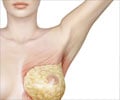Light directed at a breast tumor through a needle can provide pathologists with biological specifics of the tumor and help oncologists choose treatment...
Light directed at a breast tumor through a needle can provide pathologists with biological specifics of the tumor and help oncologists choose treatment options that would be most effective for that individual patient.
Duke University bioengineers have developed a light-based system that can quickly and easily provide important information about oxygen levels within a tumor while it is still in place. The new system, based on diffuse reflectance spectroscopy, gives researchers important clues about the tumor by interpreting how the light is either reflected back from the tumor or absorbed.Oxygen status is important, the researchers said, since past studies have shown that low levels of oxygen, or hypoxia, are more often associated with malignant tissue than healthy normal tissue. Tumors that thrive in these low-oxygen environments tend to be more difficult to treat, the researchers said.
"We developed an easy-to-use fiber-optic probe that can provide immediate and non-destructive measurements of tumor oxygenation," said J. Quincy Brown, a fourth-year post-doctoral fellow in the laboratory of Nirmala Ramanujam, associate professor of biomedical engineering at Duke's Pratt School of Engineering. The results of the Duke experiments were published April 1 in the journal Cancer Research.
"This new approach could be an important new tool for physicians in determining the aggressiveness of a specific tumor and which therapies might work best against it," Brown said. "Since this system is compatible with commonly used biopsy needles, we could make oxygen measurements at the time of a needle biopsy, providing immediate feedback about the tumor's oxygen concentration."
In their current experiments, the researchers enrolled 35 women who were to undergo surgery for their breast cancer. Before the surgery, the researchers directed normal, UV-visible light directly through a needle at the surface of the tumor while it was still in the breast. Since the system gathers information immediately, researchers are able to take readings at multiple locations in little time.
Their main target was blood and its hemoglobin, a protein which is responsible for carrying oxygen throughout the body, as well as to tumors. While some types of breast cancer thrive in environments low in oxygen, other cancers stimulate the growth of new blood vessels to feed oxygen to the tumor.
Advertisement
One interesting finding involved tumors with the gene HER2/neu. It is estimated that one in five breast cancers exhibit over-expression of the HER2/neu gene. A routinely used drug known as Herceptin, which can block HER2/neu over-expression, is only effective in treating tumors with this gene.
Advertisement
The researchers plan future studies of breast cancer patients undergoing chemotherapy by taking regular oxygen measurements to determine how a particular tumor is responding to therapy over time.
Source-Eurekalert
SRM















